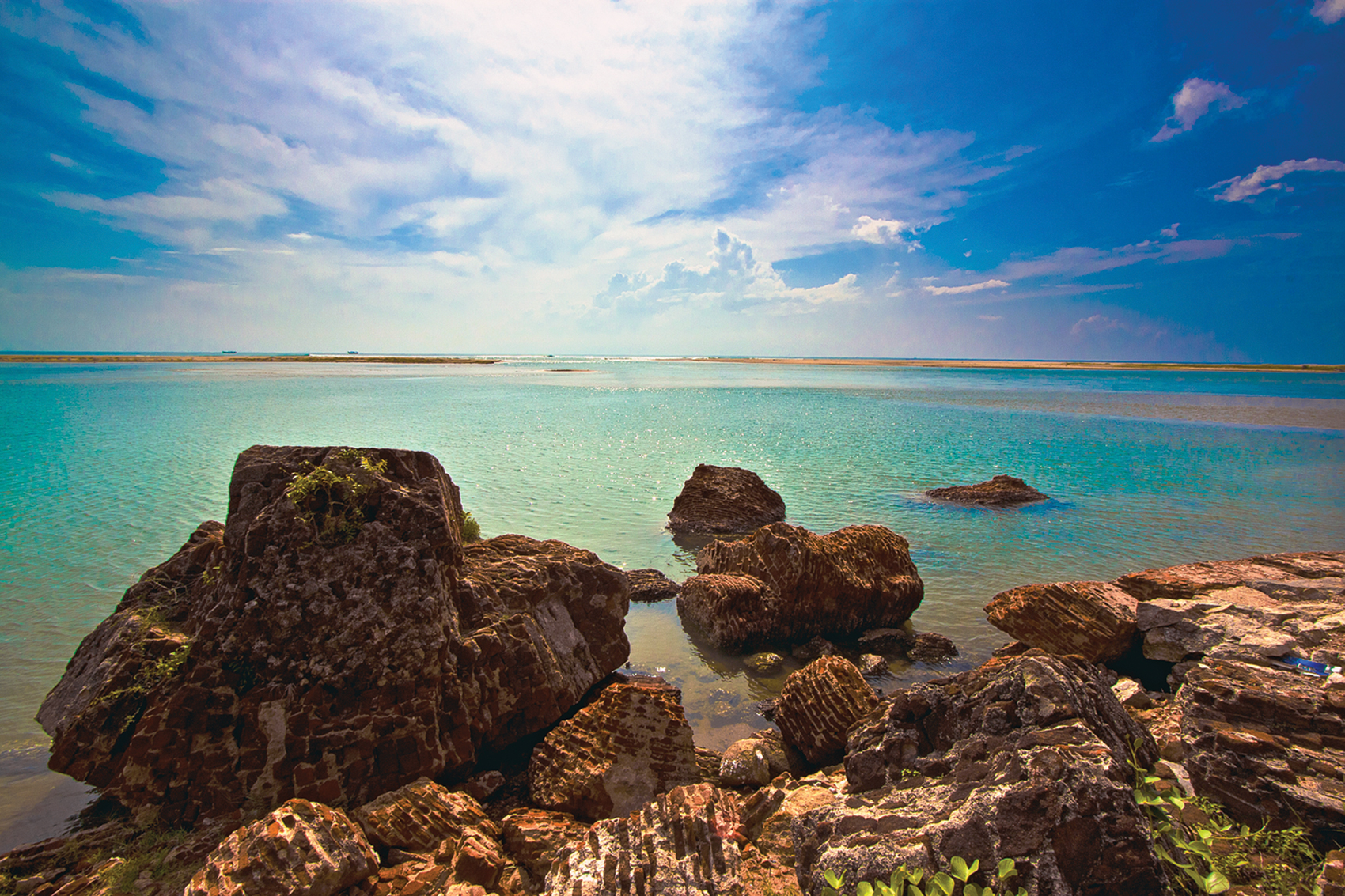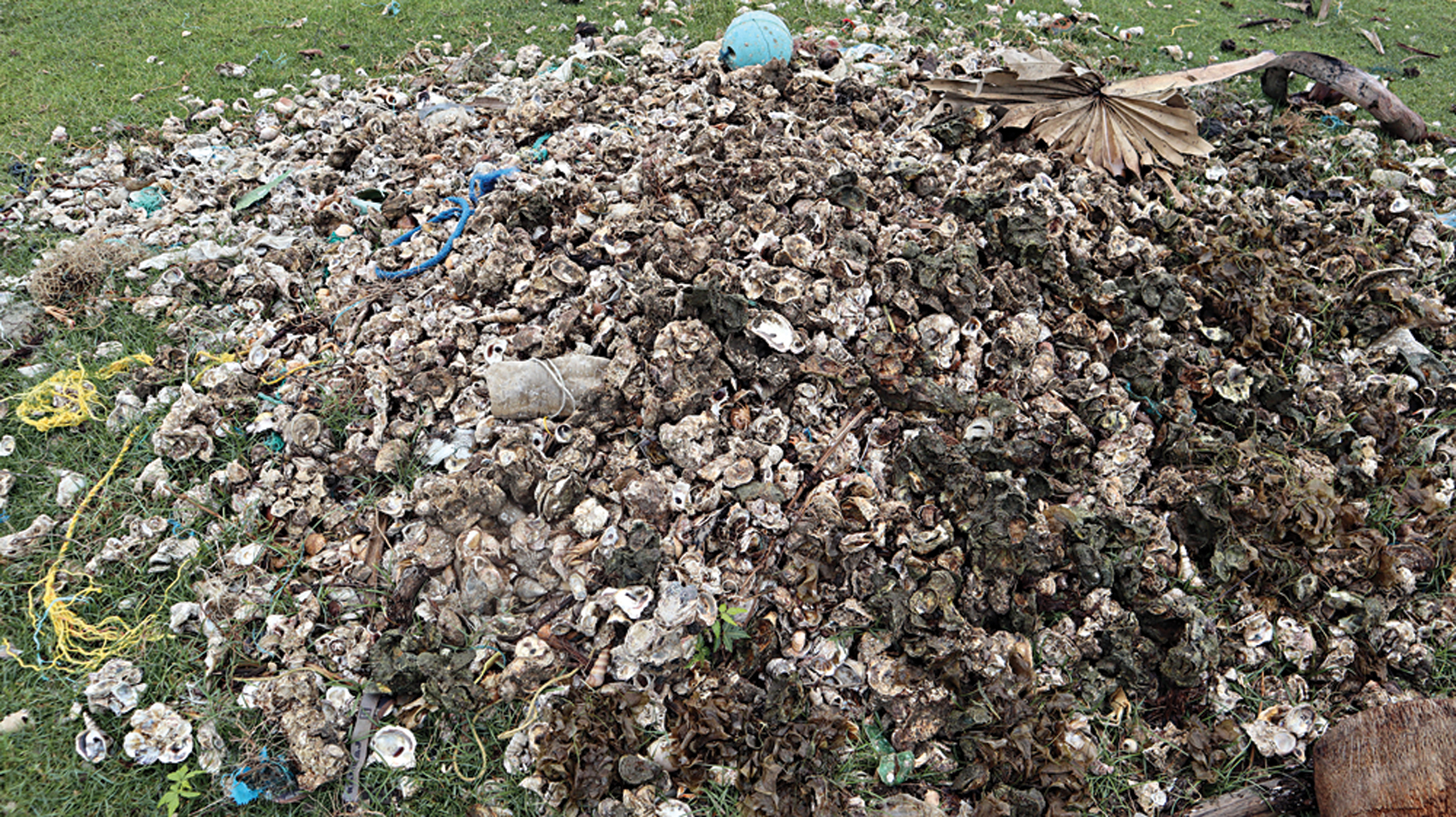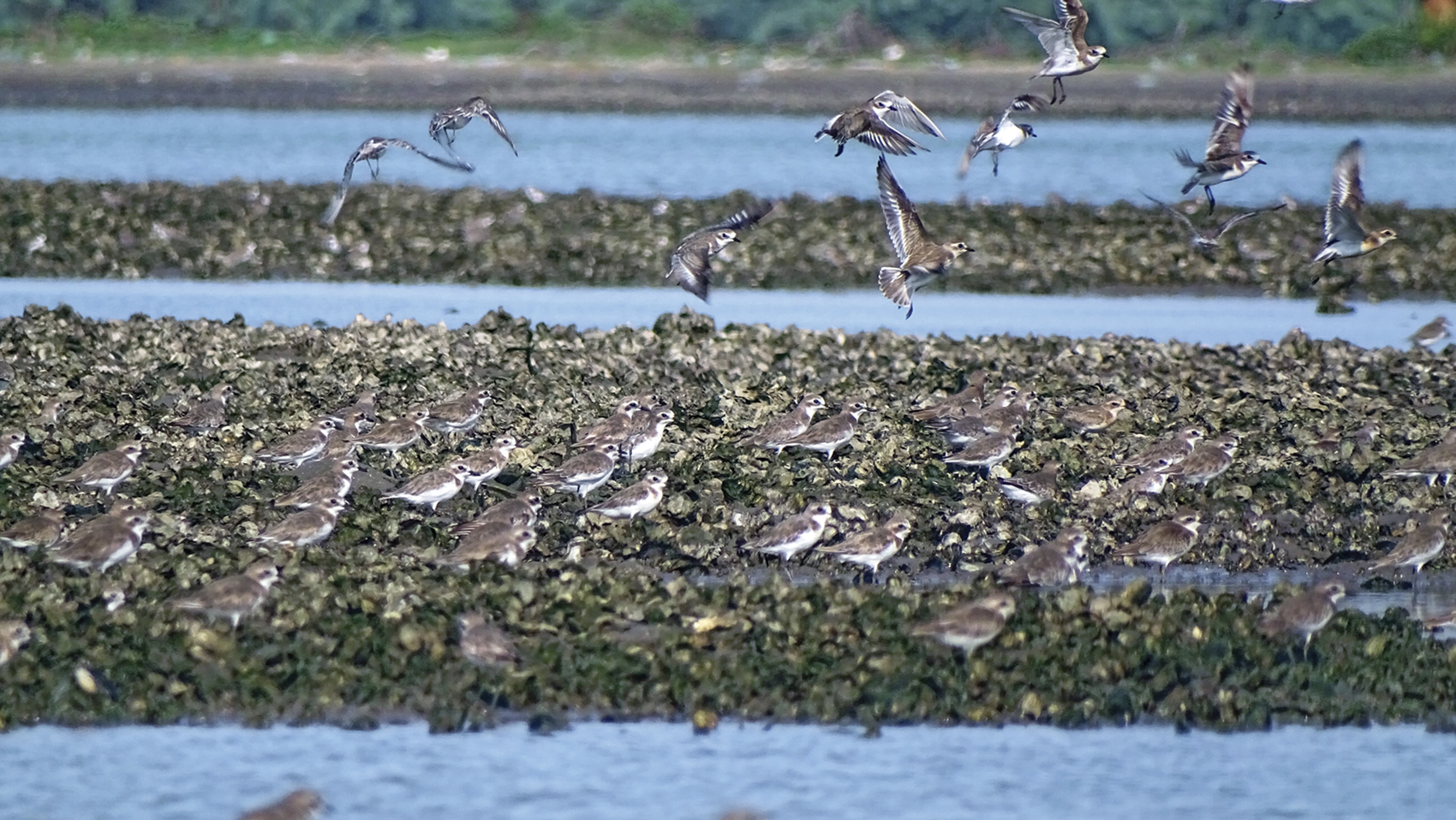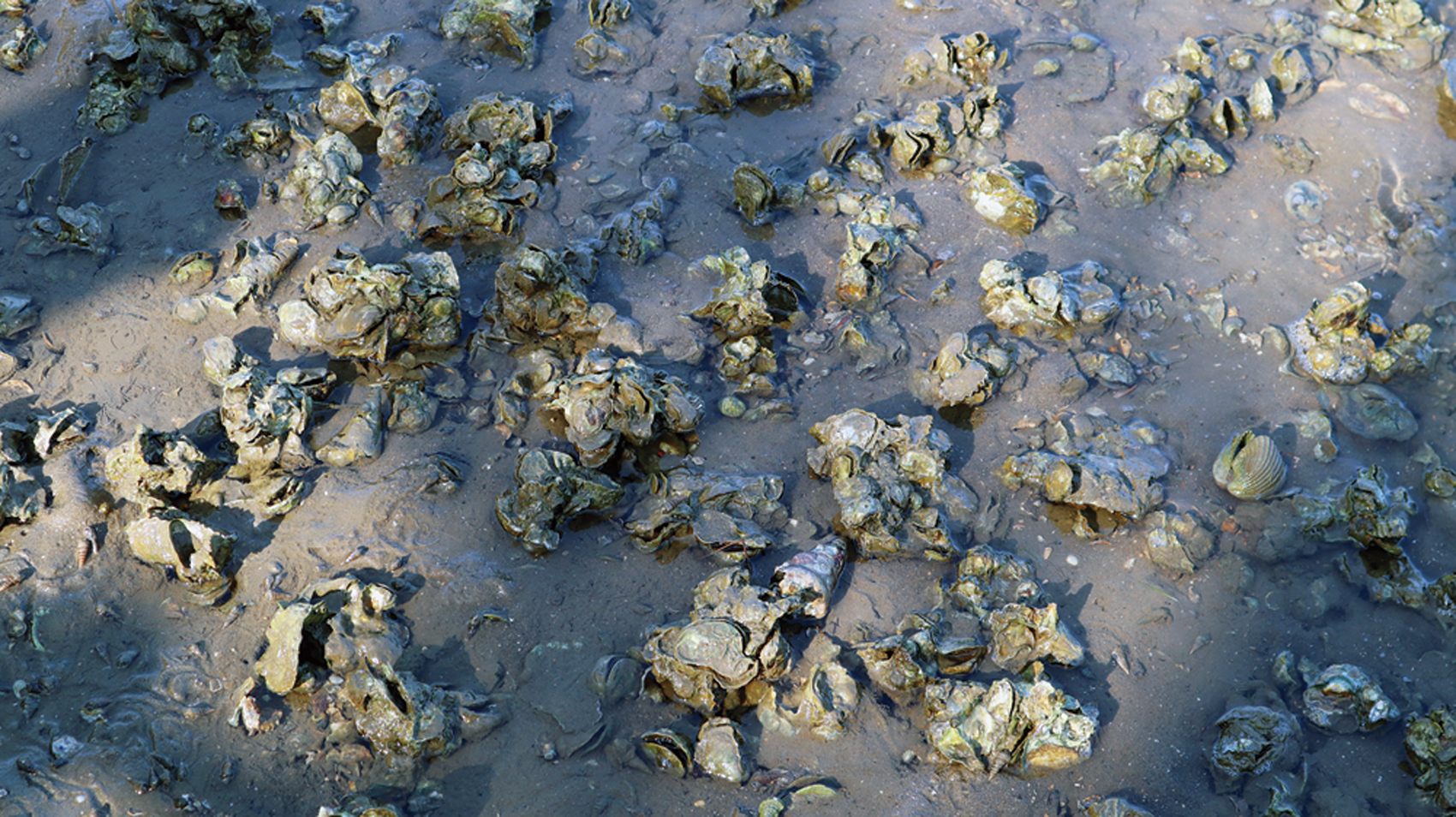The Forgotten Reefs
First published in Sanctuary Asia,
Vol. 41
No. 10,
October 2021
Oyster reefs play keystone ecological roles in coastal wetlands, and host astonishing biodiversity. Yet they remain the least studied coastal habitat in India, writes nature educator Yuvan Aves.
Under the creek, a maze unfolds. A jagged, craggy, amorphous architecture cloaked in slush stretches underwater. Its sharp edges can slice toes. Contorted petals of rock; a frozen subtidal flowerbed. A school of tiny translucent fish – each the size of a paddy grain – vanish into the asymmetry of the oysters. Their prismatic bodies recast the early sunrays into pink, red and blue. I am wading shin-deep in the backwaters near the archaeological ruins of Alamparai – a 17th century Mughal seaport, captured by the French colony, then destroyed by the British, then destroyed again for good measure by the 2004 tsunami. Now large portions of it lie under the backwaters and in the sea. A fisherman docking his boat shouts out to me to take a picture of him, then warns me to watch my feet. A large hermit crab inside a chicoreus shell sees me approaching and free-falls from the side of a brick with a plop.
This wetland has among the largest stretches of oyster reefs in northern Tamil Nadu. Rock oysters Saccostrea sp. attach and grow on the broken masses of Mughal masonry, fallen palm trunks and driftwood. Indian backwater oysters Crassostrea madrasensis bloom on mudflats, sand bars and beneath the backwaters. The ambient sound is ever of sharp bursting bubble-wrap – clap… clap… clap... clap... clap – clapping oysters exuding water. This estuary is fed by the massive Kaliveli lake, about 20 km. south, which flows into the long serpentine Uppukali creek that empties into the ocean. I have been returning here frequently to survey oysters and understand this coastal landscape, threatened from many fronts. Three commercial fishing harbours have been proposed here by the fisheries ministry with a capacity of 12,000 tonnes of catch per annum. In August 2021, the Public Works Department proposed to cut off Kaliveli lake from the creek and make it a freshwater tank for agriculture. This would desiccate the mudflats, make it saline and affect the breeding of marine and brackish water fauna. It has asked for 74 ha. of forest land to be denotified to build bunds and check dams. In 1916, the then collector of South-Arcot Azizuddin tried to do the same and control the wetland’s hydrology, to make it do his bidding. It broke down the structures which were built, flooded over, and flowed back into the sea. The Forest Department, in strange contradiction to the PWD, is fortunately considering the wetland-complex to be declared as a bird sanctuary. The area in winter hosts over 30,000 migratory ducks and 20,000-40,000 migratory shorebirds, as eBird data reveals. These saltmarshes are known for regularly hosting the Grey-tailed Tattler – a rare migratory wader seen only here and in Pulicat lagoon in the whole country. This is also a famous raptor hotspot and the highlights include the Asian Imperial Eagle, Greater Spotted Eagle, Red-necked Falcon, and several species of Harriers. During the Asian Waterfowl Censuses the sheer flocks and flux of ducks, waders, and terns to count at Kaliveli tire and challenge even the most experienced of birders.

Alamparai’s historical Mughal architecture is just as fascinating as its ecological architecture – here mangroves, seagrass and oyster reefs grow together – allowing a diversity of creatures to thrive. Photo:Public Domain/D. Joe Manoj
Understanding the Sea
To the south of the creek is the long Edaiyanthittu sand bar – jutting out and separating the creek and the ocean. Edaiyanthittu forms the southern lip of the Uppukali creek. In the last days of August 2021, my friend and fellow naturalist Rohith and I visited to survey the oyster reefs. Rohith carried with him a pansy-shell sea urchin’s test, a stunning exoskeleton, which looks just like a fossilised flower – to show to a few friends who missed the trip. Ashy Wood-swallows chattered petulantly, perched atop Casuarina trees or fanning over us with their bat-like wings. Dozens of bee-eaters were trilling brightly all over the drizzling grey sky. We first watched the fisherfolk come in with their boats near dawn and unravel their nets. This was the season for smaller fish – silver biddies mostly, but also anchovies, ribbon fish, sardines, and tongue soles. Their nets were full of brittle sea-stars and the shore had hundreds of sea urchin tests – dried or drying exoskeletons – also called sea biscuits or sand dollars. A live sea urchin is locally called Mulleli, translating to ‘thorny mouse’.
Other than the two longshore currents, one flowing south to north during most of the year (thendi), and another north to south during the Northeast monsoon (vanni), fisherfolk differentiate between two other kinds of currents, which reflects their embodied knowledge of the ocean. Olni is a thermohaline circulation, which brings colder waters from deeper parts of the Bay of Bengal towards the East coast. Babu, a 50-year-old fisherman told us that this pushes up the sea urchins, jellyfish and other free-floating creatures and casts them on the shore enmasse. In the Tamil month of Purattasi (September 17 to October 17), during the Northeast monsoon’s peak and during cyclonic weather, the Memiri circulation is perceived to happen, which is in the opposite direction to the Olni. It makes the ocean rougher and more dangerous. Babu mentioned that he has enrolled his son to study marine biology in a well-known college, but he feels he learns nothing from the virtual classes going on right now due to COVID-19. “He could as well come and learn directly from the sea,” he says.

The author came across massive heaps of harvested shells on the Kaliveli wetland shore. Fisherfolk, mostly women, spend six to eight hours picking oysters each day, and sell the dried shells to lime manufacturers. Photo: Yuvan Aves
The backwaters on the other side of the sand bar are calmer and far more predictable, and oysters live here. They are called Aazhi. Babu told us how prawns, crabs, polychaete worms and many species of fish lay eggs only around the oysters. Sometimes when he has dislodged a chunk of an oyster bed from the mudflat, he has found huge masses of prawn eggs under them. “Many of these creatures swim in from the sea and breed in the creek,” he added. Aazhi thittu means a sizable oyster bed – literally an oyster island – where the reefs are very old and have formed large intertidal and subtidal structures, defining the ecology of the habitat.
In older Tamil literature, oysters were called Kizhinjal, though now the word is used broadly for any shell. Kizhi is to tear. Nets cast carelessly into backwaters can hook onto oysters and can get cut – something fisherfolk lament about often.

Sand Plovers feast on oysters near the archaeological ruins of Alamparai, a 17th century Mughal sea port that is largely under the backwaters and in the sea. This wetland area has among the largest stretches of oyster reefs in northern Tamil Nadu. Photo: Yuvan Aves
Finding Oysters
We walked further along the sand bar, wading by the edge of the creek. In March, I had seen some extensive reefs here. Now after the rains, the creek had swollen. We saw only the harvested shell heaps on the shore. They are handpicked by fisherfolk, mostly women, to eat the flesh or to be sold to shrimp and prawn hatcheries. The dried shells are sold to lime manufacturers. The women enter the waters at about 5.30 a.m. then spend about six to eight hours wading, picking oysters, and collecting them in their pari (straw basket). They may sometimes wear socks and gloves and carry a knife to wedge the bivalves open. About 1,000 women from 20 villages around the Kaliveli wetland-complex are dependent on these oyster reefs.
Some of the harvested heaps we saw on the shore were massive, holding several hundred kilos of oyster shells, perhaps many days or weeks of accumulated collection. Pied Kingfishers had used the shells as ‘clobber’ stones. Their kills of mullet and carp lay half-eaten on the heaps, left for crows to quarrel over.
Months back, the mouth of the Edaiyanthittu creek was at least a hundred metres wide, allowing the sea to rage in. But in August-September all along the south-eastern coastline of India, creeks and estuaries get blocked. The pre-monsoon showers flush silt from all the river beds and wetlands, depositing the sediment along the shoreline. Fishers call this Aadi Vandal thanni (water laden with sediment, in the Tamil month of Aadi). This creek too was solidly blocked. Tractors could drive across now where waves used to break and where the mudflats were once dangerous quicksand stretches. So, we gladly walked over. A ghost crab had dragged a boxfish skull too big for its burrow. Now it stood wedged firmly over its home. Last year, I had seen a part of a sperm whale’s spine here – four vertebrae as tall as me and as thick as the trunk of a palm tree. Its fat fibres and marrow were thicker than cotton threads. Karthik Ashok, a friend and cetologist, tells me that this area is typical sperm whale habitat with deep marine canyons relatively close to the shore. On the other side of the creek we met Ranjith, another local fisherman, who took us on his boat deeper into the backwaters where he said Aazhi are found. Ranjith picked up oysters plunging his arm almost a metre under the creek. He knew how they grew and the sandy bottoms they preferred. He said that the smaller oysters are left behind by the pickers, and that they grew fast and all through the year here. But domestic sewage entering through the Buckingham canal and agricultural run-off has reduced their numbers significantly over the years. There has also been considerable conversion of saltmarshes to commercial salt pans – which has affected the oyster habitats and the livelihoods dependent on them. Around the reefs, girdled horn-snails and blue-striped hermit crabs within their shells, congregated densely. We counted up to 500 – 800 of them inside a one square metre quadrat. Their trails vividly doodled on the mud. Mud-creeper snails, and larger hermits using their shells, made trails in the sand like drawn fingers and like tractor marks respectively. All of them are strictly backwater species. Here we found all three important coastal ecological architects growing together – mangroves, seagrass and oyster reefs – perhaps having amongst them an interconnectedness we are yet to find out about.
A rock skipper crawls into an oyster’s lip and hides, just as I get my first oyster cut deep under my right big toe. Five whimbrels whistle as they fly from shore to shore.

More than 1,000 women from 20 villages around the Kaliveli wetland are dependent on these reefs for their livelihood. Oysters are sought after for their flesh or to be sold to shrimp and prawn hatcheries. Photo: Yuvan Aves
Restoring Balance
I discovered, from several research papers, that the diversity oyster reefs can host is comparable to corals. But more importantly, each oyster filters about 200 litres of water per day, removing algae, phytoplankton and other suspended particles and nutrients from it – making estuarine environments healthier and liveable for other creatures. Without this important ecosystem function, coastal wetlands would frequently suffocate from algal blooms and eutrophication, the reasons for mass fish-mortalities and death of other creatures due to hypoxic conditions. They are biostructures, natural breakwaters which protect shorelines from erosion – and their restoration in many countries is being done as an initiative to protect eroding coasts. In many parts of North America, military bases are installing ‘oyster-cellars’ to arrest erosion due to flooding and storms. These reefs also draw down and fix atmospheric carbon through their filtration and bio-deposition.
To understand oyster habitats better, I wanted to speak with somebody working with oyster reef restoration. The coast of Tamil Nadu, as other parts of India, still has some vast oyster formations, though in steep decline. Through a mutual friend at the University of Hong Kong, I reached out to Dr. Jay Minuti, a post-doctoral research scientist at the Marine Futures Laboratory.
Designers in the Sea

Reef building oysters are ecological architects, just like reef building corals. They create three-dimensional living structures in brackish and intertidal habitats. They do not follow the same standards of beauty and colour and aesthetics as corals do. They create their own standards of beauty, outside conventional ones. Oyster formations are amorphous, misshapen, jagged edged stony structures sealed together with their own chalky cement. They are fast rocks – rapidly turning minerals and carbon into these shell-labyrinths. They are protandric-hermaphrodites – meaning that they are male during their early life and then turn female during later stages. Their mouths and surfaces are covered in mud and algae, warted with barnacles, tubeworms, and other bivalves. They are described as ‘fouling’ organisms by seafarers – as they bind and grow on dockyards, piers, ropes, groynes, sea walls, ship hulls – adding weight to them, deforming their surfaces. Reef making oysters are not the ones which yield pearls. Yet they host extraordinary life within their rugged architecture.
Jay’s Instagram feed is enviable. Her posts and stories show her exciting field work. She is either walking and surveying vast oyster beds on the mudflats of Yung Shue, Hong Kong, or is on a ferry mid-ocean, if not measuring sea urchin parameters in her lab. Her research involves mapping oyster reefs all over Hong Kong using drones and working to restore these habitats. She told me that the most important ecosystem function of oysters are their filtration abilities; they are crucial natural water purifiers – especially in turbid brackish ecosystems. In one of her YouTube videos she shows a timelapse of oysters in a fish-tank, making murky water clear within hours, as they filter-fed. Other scientists in her lab have calculated that a reef about seven square metres large filters water the volume of an Olympic swimming pool in a single day. This made a strong case for their restoration in the coastal wetlands of Hong Kong. Jay also says that “possibly the most important aspect of oyster conservation that we try to draw attention to is their historical importance. Oyster farming used to be a very important part of the local culture, but this has been lost over time due to overfishing practices and land use change. We try to drive the message that we are searching for these ‘lost’ reefs and are trying to restore an important part of culture for the local fishing communities.” This is very much true of India too, in places like Edaiyanthittu. Right now, Jay is on a two-year project to document all the biodiversity in Hong Kong’s oyster habitats.
Over 85 per cent of the world’s oyster habitats have vanished over the last 100 years – due to over-exploitation, bottom trawling and other destructive fishing practices, pollution, and conversion of coastal wetlands into real estate. Conservation and restoration of oyster reefs for their ecological value and crucial ecosystem services is virtually absent in India, where oyster reefs still exist. These habitats need to be mapped and the life they host, uniquely in the coastal wetlands of India, needs to be documented. They are shoreline protectors and water-health keepers. They warrant to be treated with the same importance as mangroves, seagrass, sand dunes and coral reefs. Sizable oyster habitats need to come under the CRZ 1A criteria in the Coastal Regulation Zone rules under the Environment Protection Act. Their protection requires policy and legal intervention. Much more academic research, literature and public awareness is needed around these forgotten reefs. And hopefully, just as mangrove afforestation has become an important measure for restoring and making coastal areas climate resilient, oyster-reef restoration will be taken up too for the same reasons, in places they once flourished.
Yuvan Aves is a naturalist, writer, educator and activist based in Chennai. He has spent many years developing Earthcentric and child-centric education curriculum in schools and has been part of various social and environmental campaigns across India.






